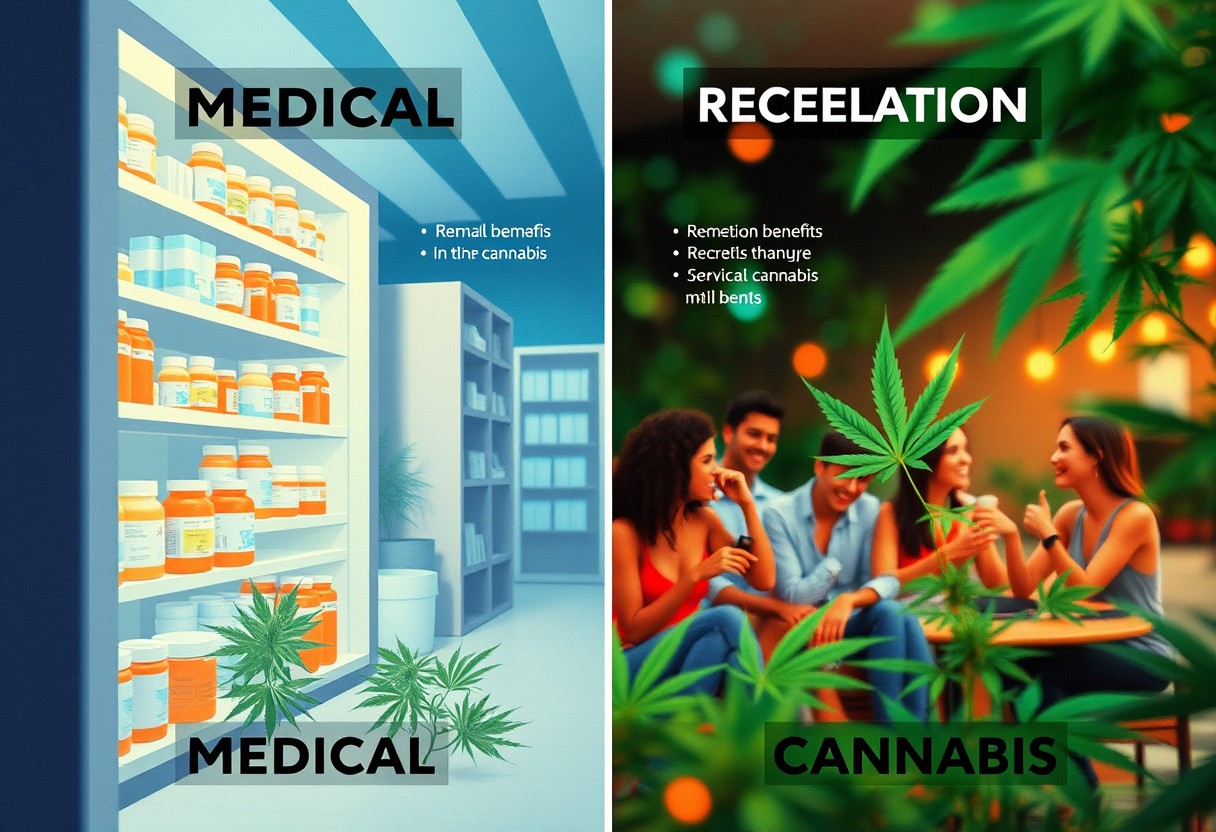Medical Vs Recreational Cannabis – 6 Steps To Differentiate Your CBD Experience

Over the past decade, cannabis has emerged as a powerful tool for both healing and recreation, but understanding the key differences between medical vs recreational cannabis is vital for maximizing your experience. As you navigate the world of CBD, recognizing the benefits, risks, and legalities associated with each type can profoundly influence your choices and outcomes. This informative guide will walk you through six necessary steps to differentiate between medical and recreational cannabis, ensuring that you make informed decisions that best suit your health and lifestyle needs.
Key Takeaways:
- Understand the Purpose: Medical cannabis is used for treating specific health conditions, while recreational cannabis is primarily for enjoyment and leisure.
- Know the Dosage: Medical cannabis often requires precise dosing under medical supervision, whereas recreational use allows for more flexible consumption.
- Be Aware of Legalities: The legal status of medical and recreational cannabis varies by jurisdiction, affecting usage, access, and regulation.
1. Understand the purpose: medical vs. recreational use.
2. Choose strains tailored to specific health needs.
3. Dosage matters: medical doses often differ from recreational.
4. Review lab testing for quality and potency assurance.
5. Consult healthcare professionals for personalized recommendations.
6. Legal regulations vary based on cannabis type and use.
Understanding Cannabis
Your journey into the world of cannabis begins with understanding its fundamental nature. Cannabis has been cultivated for thousands of years, used for various purposes, including medicinal, recreational, and industrial. This plant is rich in cannabinoids, compounds that interact with your body’s endocannabinoid system to produce a plethora of effects.
Definition of Cannabis
With a diverse range of species, cannabis is a flowering plant of the Cannabaceae family. It contains various compounds, primarily known as cannabinoids, that contribute to its unique effects and benefits.
Types of Cannabis: Sativa, Indica, and Hybrid
With three main types of cannabis, it’s vital to understand each to tailor your experience:
- Sativa: Typically energizing and elevating, ideal for daytime use.
- Indica: Known for its relaxing and sedative effects, suitable for nighttime.
- Hybrid: A balanced blend of both Sativa and Indica characteristics.
| Type | Effect |
| Sativa | Uplifting, energizing |
| Indica | Relaxing, sedative |
| Hybrid | Balanced effects |
| Usage | Day/Night |
Understanding the fundamental differences between Sativa, Indica, and Hybrid strains will help you choose the right type for your personal needs. Each strain can affect your mood, energy, and overall experience, depending on various factors such as dosage and consumption method. Knowing your strain can lead to a more satisfying cannabis experience.
Chemical Components: THC vs. CBD
Cannabis is composed of numerous cannabinoids, the two most prominent being THC (Tetrahydrocannabinol) and CBD (Cannabidiol). These compounds are responsible for the various effects experienced during use, with THC providing the psychoactive high and CBD offering therapeutic benefits without intoxication.
Another important aspect to consider is how THC and CBD interact with your body. THC is known for inducing feelings of euphoria, often accompanied by increased appetite and altered sensory perception. In contrast, CBD is celebrated for its potential anti-inflammatory and anxiolytic properties, making it beneficial in managing various health conditions. Understanding these components helps you make informed choices for your desired experience, ensuring you harness the benefits safely and effectively.
Medical Cannabis
Even as the cannabis landscape continues to evolve, understanding the nuances of medical cannabis is necessary for you. This segment is focused on how to leverage cannabis for improving your health and wellness while ensuring compliance with regulations.
Legal Status and Regulations
Medical cannabis is typically governed by specific legal regulations that differ by state or country. You need to be aware of local laws regarding the possession, use, and prescription of cannabis, as these regulations dictate how you can safely access medical cannabis.
Common Medical Uses of Cannabis
Commonly, medical cannabis is utilized to alleviate symptoms associated with various conditions, including chronic pain, anxiety disorders, and nausea caused by chemotherapy. It can also serve as an appetite stimulant for those recovering from illnesses.
Another significant application is in managing neurological conditions, where cannabis may help reduce seizures in epilepsy patients. Additionally, it may prove beneficial for individuals suffering from conditions like PTSD and multiple sclerosis, providing relief from debilitating symptoms.
How Medical Cannabis is Administered
Regulations surrounding medical cannabis also dictate how it is administered. Methods include oral consumption through edibles or capsules, inhalation via vaporizers, or topical applications. Each method has unique implications for absorbing the active compounds into your system effectively.
Plus, understanding the various routes of administration can empower you to choose the one that best matches your lifestyle and therapeutic needs. Inhalation may provide quick relief, while edibles may deliver longer-lasting effects, making it vital for you to select wisely.
Efficacy of Medical Cannabis for Various Conditions
On the whole, numerous studies indicate that medical cannabis may be effective for a variety of conditions. As you navigate your options, it’s crucial to remain informed about potential benefits, as well as the risks involved.
Administered correctly, medical cannabis can significantly enhance your quality of life, particularly when traditional treatments may fall short. However, always consult a healthcare provider to create a personalized treatment plan tailored to your specific condition, ensuring both safety and efficacy.
Recreational Cannabis
Now that you have an understanding of medical cannabis, let’s shift our focus to recreational cannabis. This type of cannabis is primarily used for its psychoactive effects and is often sought after for relaxation, enjoyment, and social experiences. Understanding the various aspects of recreational cannabis can enhance your overall experience.
Legal Status and Regulations
Legal recreational cannabis varies significantly across regions. In some areas, it is fully legal for adults, while in others, it might be restricted or prohibited altogether. Familiarizing yourself with local laws is crucial to ensure that you are compliant with legal regulations surrounding possession, consumption, and purchasing.
Popular Strains and Their Effects
The most sought-after strains of recreational cannabis include popular varieties like Blue Dream, OG Kush, and Sour Diesel. Each strain often elicits different effects; for instance, some may provide a calming sensation, while others are known for their uplifting and euphoric properties. Understanding these effects is crucial for tailoring your experience to your desires.
Another noteworthy aspect is that recreational strains are usually bred to enhance certain characteristics, such as flavor and potency. Indica strains tend to produce a relaxed body high, while sativa strains are typically more energizing and cerebral. You may want to explore hybrids that offer balanced effects combining both types, thereby allowing you to find the perfect strain for your needs.
Cultural Significance and Social Use
To understand recreational cannabis fully, it’s crucial to recognize its cultural significance and role in social interactions. Many people associate cannabis use with personal expression, artistic pursuits, and gatherings with friends. The social fabric surrounding cannabis has evolved, transforming it into a means for bonding and creating shared experiences.
Their role has also been enhanced by the growing acceptance of cannabis use in various media and art forms, promoting an inclusive social environment. Engaging in recreational cannabis can enrich your social circle, expanding connections with others who share similar interests and values in this versatile plant.
Safety and Responsible Consumption
On the subject of safety, it’s vital to practice responsible consumption. Start with lower dosages, especially if you are new to recreational cannabis, and always be mindful of your environment. Keeping track of your limits will help ensure you have a positive and enjoyable experience without unexpected side effects.
Significance cannot be overstated, as responsible use minimizes risks associated with overconsumption, such as anxiety or discomfort. By being aware of *your limit* and choosing a suitable setting for your consumption, you can fully benefit from the pleasurable aspects of recreational cannabis without jeopardizing your wellbeing.
Differentiating CBD Experiences
Keep in mind that your experience with CBD can vary significantly based on several factors, including the type of product you choose. Understanding the differences between medical and recreational cannabis is necessary for tailoring your CBD experience. For more information, check out this useful guide on CBD vs Cannabis/THC – What’s the Difference?
Understanding CBD Isolate, Broad-Spectrum, and Full-Spectrum
For you to fully appreciate your CBD experience, it’s crucial to be aware of the different forms of CBD: isolate, broad-spectrum, and full-spectrum. CBD isolate contains only CBD, while broad-spectrum includes additional cannabinoids but no THC. In contrast, full-spectrum contains a range of cannabinoids, including trace amounts of THC, contributing to the entourage effect that may enhance the product’s therapeutic benefits.
The Role of Terpenes in CBD
With terpenes playing an necessary role in your CBD experience, it’s important to know they contribute not only to the aroma but also to the potential effects of your CBD products. Each terpene boasts unique properties that can enhance or modify the effects of CBD, leading to a more tailored experience.
Experiences with terpenes can significantly influence how you feel after consuming CBD. For instance, terpenes like myrcene may promote relaxation, while limonene can create an uplifting mood. By choosing products high in specific terpenes, you can align the effects of CBD more closely with your personal wellness goals. Always consider the terpene profile when selecting your CBD products to optimize your experience.
Targeted Benefits of CBD
Experiences with CBD can be enhanced by targeting specific benefits such as pain relief, anxiety reduction, or improved sleep quality. Understanding what you want to achieve will help you choose the most effective product for your needs.
Benefits of targeting your CBD use can be profound, allowing you to focus on alleviating specific symptoms. For example, if your objective is to combat anxiety, you may opt for a CBD product known for its anxiolytic properties. Conversely, if your goal involves reducing inflammation, you’ll want a product rich in anti-inflammatory compounds and potentially enhanced with specific terpenes. Tailoring your CBD experience can lead to more effective outcomes based on your health and wellness aspirations.
Six Steps to Differentiate Your CBD Experience
Despite the growing popularity of cannabis, understanding the differences between medical and recreational products can be confusing. For a clear explanation, check out What is the Difference Between Medical vs. Recreational …. By following these six steps, you can better tailor your CBD experience to your individual needs.
Step 1: Assessing Your Needs and Goals
With a variety of CBD products available, it’s crucial to define your specific needs and goals before making a decision. Are you seeking relief from a medical condition, or are you looking for relaxation and stress relief? Your goals will guide your choices.
Step 2: Researching Product Ingredients
Researching product ingredients is crucial in distinguishing between medical and recreational CBD. Always check the labels and descriptions of the products you’re considering. Ensure you understand the key components, as they can significantly affect the product’s effectiveness.
Ingredients in CBD products can include various cannabinoids, terpenes, and other beneficial compounds. Pay attention to whether the product is full-spectrum, broad-spectrum, or isolate, as these formulations affect the overall experience. Understanding the specific ingredients will empower you to choose a product that best suits your needs.
Step 3: Understanding Dosage and Potency
Step into the world of dosages and potency as you navigate through CBD options. Knowing the suggested dosages and the product’s potency helps ensure you get the desired effects without any unwanted side effects.
Assessing dosage and potency involves understanding your individual tolerance and how your body reacts to CBD. Start with a lower dose and gradually increase it until you find the sweet spot. This strategy minimizes risks and maximizes beneficial outcomes for your unique experience.
Step 4: Comparing Medical vs Recreational Cannabis Products
To effectively compare medical and recreational products, consider the following aspects:
| Medical Products | Recreational Products |
|---|---|
| Formulated for specific health conditions | Designed primarily for enjoyment |
| May require a prescription | Available over-the-counter |
| Higher quality control and testing | Varied quality and testing |
Potency differences also play a significant role in your choice between medical and recreational products. Medical CBD products typically have a higher concentration of therapeutic compounds, while recreational options may focus more on THC content, leading to different effects.
Step 5: Consulting with Healthcare Professionals
On your journey toward understanding CBD, consulting with healthcare professionals can provide invaluable insight. They can help guide your decisions and ensure that your chosen products align with your health needs.
Product recommendations from healthcare professionals are based on their knowledge of your unique health situation. Discuss any concerns and ask questions to gain a clearer understanding of potential interaction effects with your existing medications or health conditions.
Step 6: Monitoring Effects and Adjusting Use
Ingredients need to be monitored continuously; pay attention to how each product affects you. Keeping a journal can help you evaluate your experiences effectively. Note any changes in symptoms, side effects, or overall well-being.
It is crucial to stay aware of how your body responds to different CBD products and adjust your use accordingly. If you notice adverse effects or find something is not working as intended, don’t hesitate to *modify your approach*. Your experience is unique, and personal adjustments will optimize your overall enjoyment and therapeutic effects.
Considerations for Consumers
All consumers should carefully consider the various aspects of cannabis consumption, especially when navigating between medical and recreational options. Understanding the differences can greatly enhance your experience and ensure you choose the right product for your needs. For more information on the distinctions, check out Medical vs. Recreational Weed: What’s the Difference?.
Choosing Quality Products: What to Look For
An vital aspect of your cannabis journey is selecting high-quality products. Look for brands that provide third-party lab testing results, as this ensures the purity and potency of their offerings. Transparent labeling and information about the cannabis strains used will also help you make informed choices tailored to your preferences.
Risks and Benefits of Cannabis Consumption
Quality cannabis offers various benefits such as pain relief, anxiety reduction, and improved sleep. However, it’s crucial to be aware of potential adverse effects, including dependency and cognitive impairment. Understanding both sides of the equation allows you to make informed decisions about your consumption.
Risks associated with cannabis consumption can vary among individuals. Some may experience anxiety, paranoia, or impaired judgment, particularly with high-THC products. These effects can disrupt daily activities and interpersonal relationships. That’s why it’s vital to start with low doses and choose strains that suit your specific health conditions or lifestyle.
Navigating State and Federal Laws
Look to stay informed about state and federal cannabis laws, as these regulations can significantly impact your access to both medical and recreational products. Being aware of your local laws can help you avoid legal issues related to cannabis purchase and consumption.
What you may not realize is that while some states have legalized cannabis for recreational use, it may still be considered illegal at the federal level. This discrepancy can lead to confusion and complications regarding possession limits, transport, and sales. It’s vital to understand the legal landscape before making any decisions related to cannabis consumption.
Summing up
Upon reflecting on the distinctions between medical and recreational cannabis, it’s clear that understanding these differences enhances your CBD experience. By recognizing the purpose of your usage, the strain types, legal implications, and dosage regulations, you can make informed decisions that align with your goals—whether seeking relief or relaxation. Being well-informed will not only elevate your experience but also ensure compliance with laws, helping you navigate your cannabis journey safely and responsibly.
FAQ
Q: What are the main differences between medical and recreational cannabis?
A: The primary difference between medical and recreational cannabis lies in its usage and regulation. Medical cannabis is prescribed by a healthcare professional to treat specific medical conditions or symptoms, allowing for a more targeted therapeutic effect. It usually contains higher levels of CBD and varying levels of THC depending on the condition it is being used to treat. Recreational cannabis, on the other hand, is intended for personal enjoyment and leisure, often containing higher levels of THC which provides psychoactive effects. Additionally, the legal regulations governing access and use of both types vary by jurisdiction.
Q: How can I differentiate my CBD experience between medical and recreational use?
A: Differentiating your CBD experience requires a clear understanding of your intentions and health needs. Here are six steps that can help:
1. **Consult a Healthcare Professional:** For medical use, consult your doctor to understand which CBD products may benefit your condition.
2. **Identify Your Needs:** Determine whether you’re seeking relief from a medical condition or if you are looking for relaxation and enjoyment.
3. **Choose the Right Product:** For medical purposes, consider full-spectrum CBD oils high in CBD and low in THC. For recreational purposes, products with higher THC content may be more suitable.
4. **Dosage:** Medical users should follow a prescribed dosage, while recreational users can experience with appropriate caution.
5. **Quality and Source:** For medical cannabis, opt for products from reputable dispensaries with third-party testing. Recreational users should also prioritize quality but may have more flexibility.
6. **Legal Compliance:** Always be aware of your local laws regarding medical and recreational cannabis use to ensure compliance.
Q: Can I use recreational cannabis for medical purposes?
A: Yes, some individuals may find relief from various symptoms using recreational cannabis, especially if they prefer not to navigate the medical cannabis system. However, it is important to note that recreational products may not be formulated with the same care or intended for therapeutic outcomes as medical products. Users should carefully monitor their responses to these products and consult with a healthcare professional for guidance, especially if they have pre-existing medical conditions or are taking other medications.














